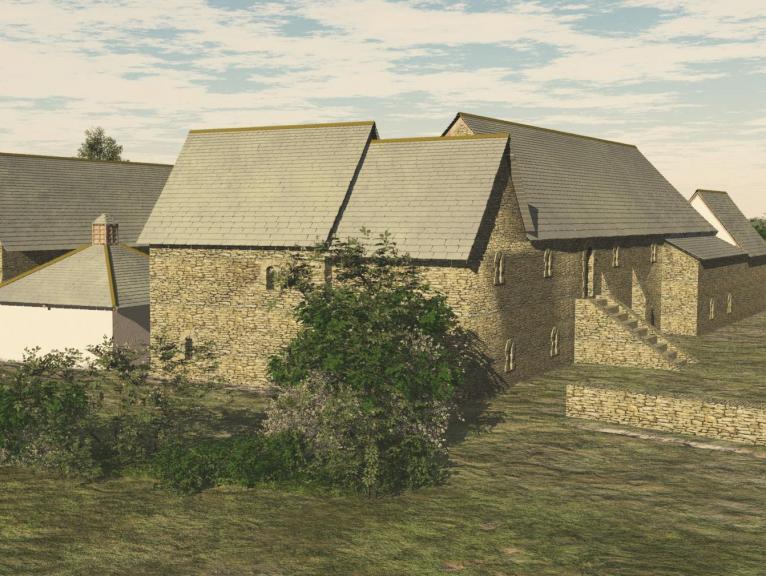Something Changed
The team from the Wessex Archaeology Sheffield office has recently been investigating a site which tells the story of the city in miniature.
Located on the western fringe of the historic core of Sheffield, Hollis Croft was agricultural land for centuries, first open land – the ‘Town Field’– and then enclosed. However, its character became radically different when it was swept along by the changes of the Industrial Revolution. Historic maps from the late 18th century onwards show steelworks, various toolmakers' premises, workers' housing and pubs appearing and proliferating on the site. Occupied by Footprint Tools Ltd for much of the 20th century, this part of Hollis Croft is currently gaining a new lease of life thanks to the construction of a multi-million pound mixed commercial and student housing development.
Wessex Archaeology was commissioned by Johnson Associates (UK) Ltd, working on behalf of GL Europe RE2 Holdings SARL, to investigate the history of the site in advance of the latest development.


Significant archaeological material was uncovered during the on-site investigations and the recording of these was performed in a professional manner whilst also understanding the programme and commercial constraints of the construction project.
Common People
Working in collaboration with the South Yorkshire Archaeological Service, archaeological advisors to Sheffield City Council, our early works involved undertaking historic building recording followed by a scheme of archaeological evaluation trenching. This discovered that substantial historic remains relating to the site’s steel working past survived beneath the modern buildings. Open area excavation revealed well-preserved industrial archaeology comprising steelmaking furnaces and a network of brick-built flues, along with traces of the workers’ housing and their local pubs (The Cock, and The Orange Branch). A wide range of finds was collected, indicative of both the technical details of the industrial processes taking place, but also the everyday lives of Sheffielders who lived and worked at Hollis Croft in the past.
Due to its proximity to Sheffield city centre, the site attracted a great deal of public and media interest. During the course of the excavations we were interviewed by ITV, BBC Radio 4, BBC Look North, BBC Radio Sheffield, and The Sheffield Star. Most importantly, members of the public were also able to see the site for themselves, thanks to a popular programme of tours and open days. We often look at archaeology from the removed position of the present, but Hollis Croft brought out some very real and poignant memories from our visitors, including those who had once worked at the site. It is these first-hand accounts and connections that bring the past alive; we are spurred on by the interest shown by the public in our work.


The archaeological investigation did conclude in accordance with the required programme and the main construction works commenced on programme.
Read about our open days here, and one of the site’s more unusual finds here.
The Hollis Croft Story
All our findings have been brought together in a final report and the physical archive (including finds) was subsequently deposited with Museums Sheffield under SHEFM:2019.13 and Sheffield Archives.
But when it came to dissemination of the results, we went off the beaten track. Inspired by a great deal of public interest, aided and hosted by Internet Archaeology, we are proud to say that we have published a comic book.
The comic, ‘Hollis Croft: a matter of time’, uses the factual historical and archaeological context of the site and local landscape but is a work of fiction. It is free to access and download in digital format and available to print out, it is also available to buy through print on demand through Oxbow Books.


Locations in the comic are as they were in 2017 and 1850. Victorian Hollis Croft in Victorian Sheffield is reconstructed by using the archive from the excavation, historic Ordnance Survey maps and written records.
The language in the book does not try to illustrate Yorkshire accent and most certainly does not reconstruct Yorkshire slang in Victorian England. Some words in the text would have not been in use then, but the places (streets and buildings) are as close as possible to those of the mid-19th century.
All names and characters are product of (Mili’s) imagination apart from the two: Pablo Fanque (circus owner) and Madame Naomi (palmist) who are historical figures. All characters are used fictitiously.
An X on each of 12 full page illustrations marks the ‘clickable spot’, which, when selected, takes the reader straight to the archive of the site and the project – Hollis Croft: a matter of time.
1300 m2 of archaeology exposed
2 cementation furnaces and 2 crucible furnaces discovered
350 pottery vessels and 300 fragments of clay tobacco pipe collected



